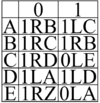5-state busy beaver winner: Difference between revisions
No edit summary |
No edit summary |
||
| Line 2: | Line 2: | ||
==Description== | ==Description== | ||
[[File:5-state_Busy_Beaver_TransitionTable.png|right|100px|thumb|The transition table of the 5-state busy beaver winner.]] | [[File:5-state_Busy_Beaver_TransitionTable.png|right|100px|thumb|The transition table of the 5-state busy beaver winner.]] | ||
The 5-state busy beaver winner essentially maintains an integer variable <math>x</math> | The 5-state busy beaver winner essentially maintains an integer variable <math>x</math> starting at 0, which is represented on the tape as <math>x</math> consecutive <math>1</math>s. After some steps, the head will instead find itself to the left of a series of <math>001</math>s on the tape. If <math>x</math> was congruent to 2 modulo 3 then this machine will halt; otherwise, the head will move back and forth many times, replacing one-by-one every "block" of <math>001</math> with <math>1</math>s. Because each back-and-forth movement makes the head visit two new cells on the left, turning them into <math>1</math>s, the new value for <math>x</math> is approximately <math display="inline">\frac{5}{3}x</math>. The space-time diagram of this machine appears similar to that of a [[Bell]]. | ||
==Attributions== | ==Attributions== | ||
The 5-state busy beaver winner and its step count were first reported on by Heiner Marxen and Jürgen Buntrock in February 1990<ref>H. Marxen and J. Buntrock. Attacking the Busy Beaver 5. Bulletin of the EATCS, 40, pages 247-251, February 1990. https://turbotm.de/~heiner/BB/mabu90.html</ref> | The 5-state busy beaver winner and its step count were first reported on by Heiner Marxen and Jürgen Buntrock in February 1990.<ref>H. Marxen and J. Buntrock. Attacking the Busy Beaver 5. Bulletin of the EATCS, 40, pages 247-251, February 1990. https://turbotm.de/~heiner/BB/mabu90.html</ref> The high-level rules were first demonstrated by Michael Buro in November 1990.<ref>Buro, Michael (November 1990). "Ein Beitrag zur Bestimmung von Rados <math>\Sigma(5)</math> oder Wie fängt man fleißige Biber?" [A contribution to the determination of Rado's <math>\Sigma(5)</math> - or - How to catch busy beavers?]. ''Schriften zur Informatik und angewandten Mathematik'' (Report No. 146). Rheinisch-Westfälische Technische Hochschule Aachen. https://skatgame.net/mburo/ps/diploma.pdf</ref> | ||
== Analysis == | == Analysis == | ||
Let <math>g(x):=0^\infty\;\textrm{<A}\,1^x\;0^\infty</math>. Then<ref>Pascal Michel. Behavior of busy beavers. https://bbchallenge.org/~pascal.michel/beh#tm52a</ref> | Let <math>g(x):=0^\infty\;\textrm{<A}\,1^x\;0^\infty</math>. Then,<ref>Pascal Michel. Behavior of busy beavers. https://bbchallenge.org/~pascal.michel/beh#tm52a</ref> | ||
<math display="block">\begin{array}{|lll|}\hline | <math display="block">\begin{array}{|lll|}\hline | ||
g(3x)&\xrightarrow{5x^2+19x+15}&g(5x+6),\\ | g(3x)&\xrightarrow{5x^2+19x+15}&g(5x+6),\\ | ||
Revision as of 18:14, 1 March 2025
The 5-state busy beaver winner is the Turing machine whose step count determines BB(5). Up to permutations, that machine is 1RB1LC_1RC1RB_1RD0LE_1LA1LD_1RZ0LA (bbch), which halts after 47176870 steps with 4098 ones on the tape.
Description

The 5-state busy beaver winner essentially maintains an integer variable starting at 0, which is represented on the tape as consecutive s. After some steps, the head will instead find itself to the left of a series of s on the tape. If was congruent to 2 modulo 3 then this machine will halt; otherwise, the head will move back and forth many times, replacing one-by-one every "block" of with s. Because each back-and-forth movement makes the head visit two new cells on the left, turning them into s, the new value for is approximately . The space-time diagram of this machine appears similar to that of a Bell.
Attributions
The 5-state busy beaver winner and its step count were first reported on by Heiner Marxen and Jürgen Buntrock in February 1990.[1] The high-level rules were first demonstrated by Michael Buro in November 1990.[2]
Analysis
Let . Then,[3]
Consider the configuration . After one step this configuration becomes . We note the following shift rule: Using this shift rule, we get after steps. If , then we get four steps later. Another shift rule is needed here: In this instance, is substituted for , which creates three different scenarios depending on the value of modulo 3. They are as follows:
- If , then in steps we arrive at , which is the same configuration as .
- If , then in steps we arrive at , which in five steps becomes , equal to .
- If , then in steps we arrive at , which in three steps halts with the configuration , for a total of steps from .
Returning to , if , then in three steps it changes into . Here we can make use of one more shift rule: Doing so takes us to in steps, which after one step becomes the configuration , equal to . To summarize: We have . As a result, if , we then get and the above rule is applied until we reach , equal to , in steps for a total of steps from (with we see the impossible configuration , but it reaches in 15 steps regardless). However, if , we then get which reaches , equal to , in steps ( steps total).
The information above can be summarized as[4]
Substituting , , and to each of these cases respectively gives us our final result.
Trajectory
The initial blank tape represents , and the Collatz-like rules are iterated 15 times before halting: To view an animation of becoming in 365 steps, click here.
References
- ↑ H. Marxen and J. Buntrock. Attacking the Busy Beaver 5. Bulletin of the EATCS, 40, pages 247-251, February 1990. https://turbotm.de/~heiner/BB/mabu90.html
- ↑ Buro, Michael (November 1990). "Ein Beitrag zur Bestimmung von Rados oder Wie fängt man fleißige Biber?" [A contribution to the determination of Rado's - or - How to catch busy beavers?]. Schriften zur Informatik und angewandten Mathematik (Report No. 146). Rheinisch-Westfälische Technische Hochschule Aachen. https://skatgame.net/mburo/ps/diploma.pdf
- ↑ Pascal Michel. Behavior of busy beavers. https://bbchallenge.org/~pascal.michel/beh#tm52a
- ↑ Aaronson, S. (2020). The Busy Beaver Frontier. Page 10-11. https://www.scottaaronson.com/papers/bb.pdf